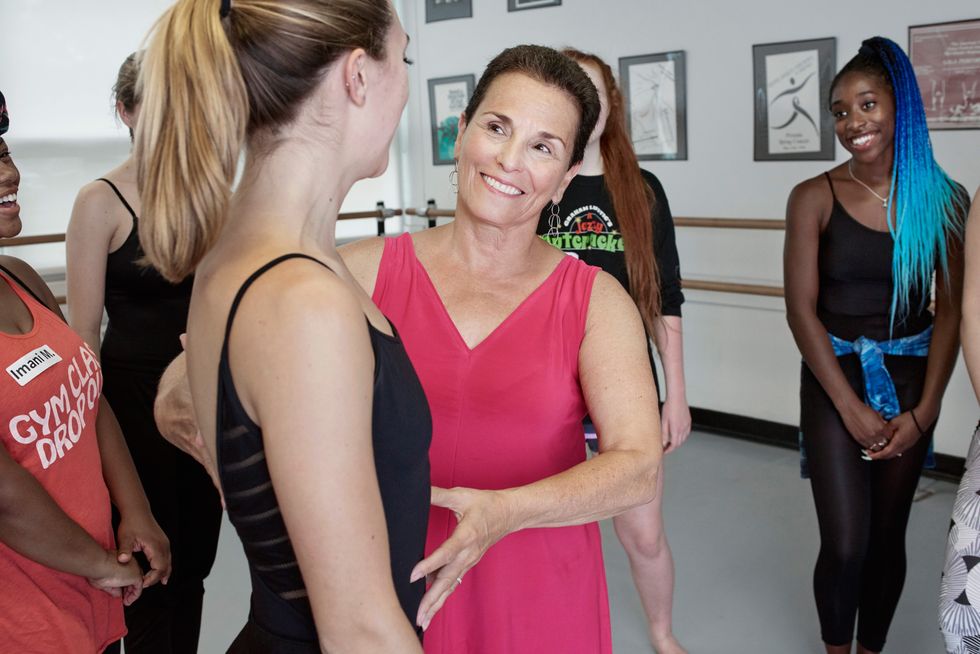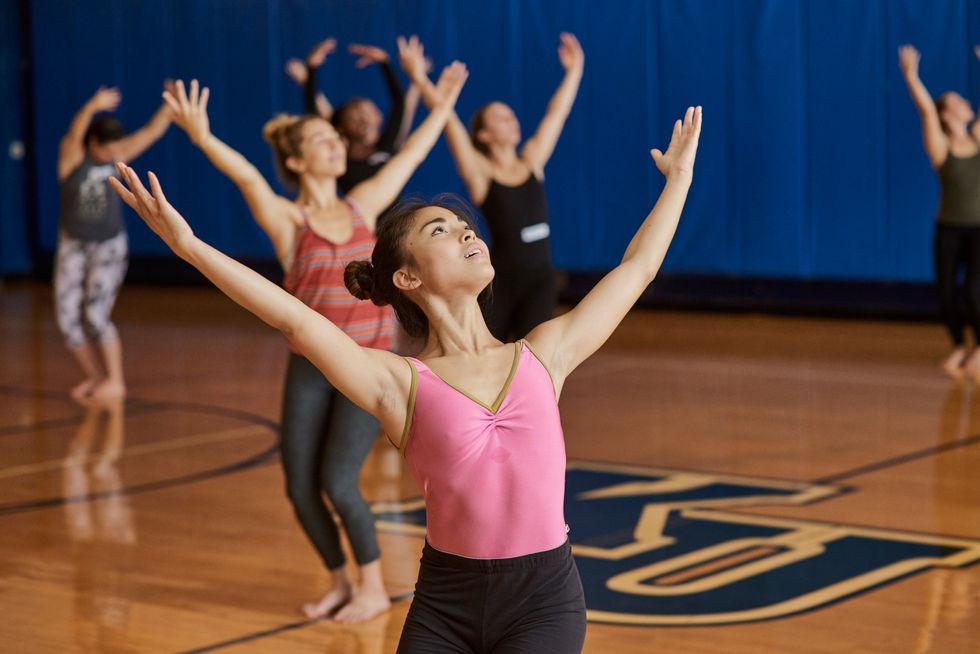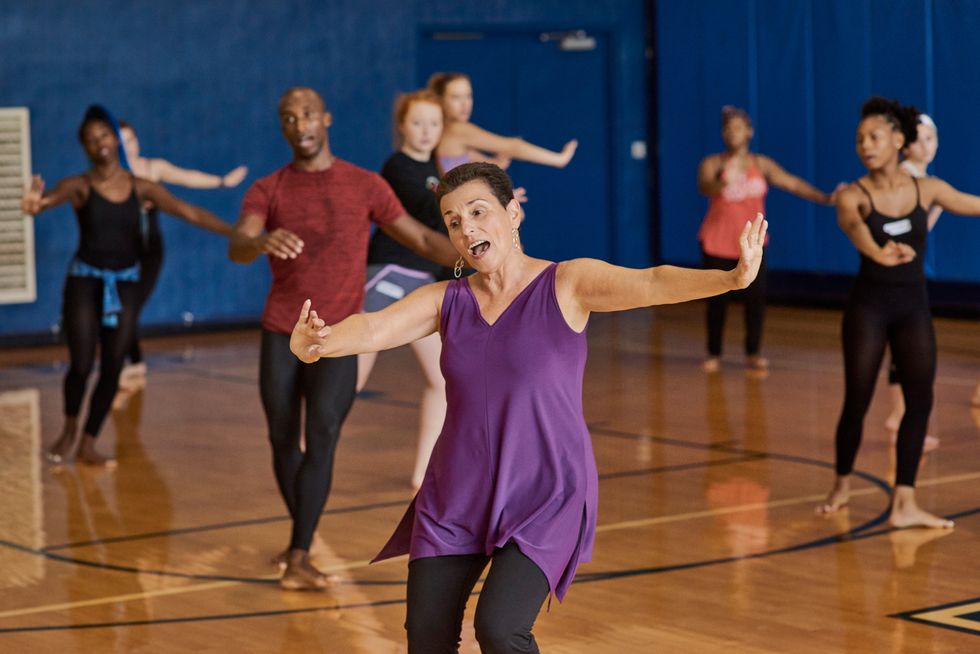
When taking dance classes as a child, Carolyn Dorfman’s teachers insisted her hyperextended knees were beautiful. Instinctively, she knew they weren’t quite right. And so began a lifelong investigation of human anatomy and movement. Now one of New Jersey’s most highly regarded educators, Dorfman brings a cerebral yet imaginative approach to art and dance education through her 12-member company, Carolyn Dorfman Dance, and the outreach programs they conduct in New Jersey and beyond.
Active with the New Jersey Performing Arts Center in Newark, where she heads the Dance Division in Arts Education and serves as honorary co-chair of the Celebrate Dance Advisory Committee, Dorfman has been recognized with the Prudential Prize for nonprofit leadership, numerous choreography fellowships from the NJ State Council on the Arts, and the Dance Advocate Award from Dance NJ. Her latest undertaking, along with her board, is to raise $100,000 over three years for a new company initiative, DEPTH (Dance That Empowers People to Be More Human). Carolyn Dorfman Dance was started 35 years ago to not only create and produce contemporary dance, but also deliver arts-in-the-schools programs, including K–12 residencies, teacher training, master classes and workshops, and “Back Stage Pass,” a series of lecture performances.

Dorfman leads class at NJ SummerDance 2017, held at Kean University. Photo by Jim Lafferty.
A Lifetime of Learning
The child of Holocaust survivors, Dorfman adopted a mature worldview early on. “There is something about being grounded in that reality and wanting to understand human nature that comes from growing up with my parents,” she says. “I dance and want to know about the full spectrum of life: the joys and the triumphs, yes, but also the sorrow and pain.” Since dance touches the expanses of experience—and can also communicate differences in experience between people—Dorfman decided it was the perfect tool for growth.
After a Graham class left her uninspired, the 14-year-old Dorfman discovered Doris Humphrey; specifically, a performance of Humphrey’s Passacaglia & Fugue in C Minor. She enrolled in summer programs and knew from the beginning that she wanted to teach. “I always had a tight body. It was really my own discomfort that made me want to seek out knowledge,” she says, with a laugh. While earning her BFA at University of Michigan, she also obtained a K–12 certificate.
“In college I could’ve taken advanced modern classes, but I took the foundational options: I wanted to understand everything from the ground up,” she says. “I’m an inside-out dancer, and that’s because I’m a common-sense person.”

Photo by Jim Lafferty
Dorfman originally moved to New Jersey so her husband could attend medical school at Rutgers. Soon, she began working as an assistant professor of dance at Centenary College, and that’s when she founded her company. “There were simply fewer artists, and I was able to grow, learn, develop and rise here,” she says about making a career in New Jersey. “Now, the arts leaders in New Jersey work together within and across disciplines. That’s been pivotal in keeping our support alive.”
Taking Art Into New Jersey Schools
Carolyn Dorfman Dance currently leads dance programs in 15 New Jersey public schools, reaching more than 6,000 students every year. DEPTH, the new funding initiative, has enabled Dorfman to, among other things, add four New Jersey school–based dance programs this fall, plus a special student assembly presented by LaGuardia Performing Arts Center of Long Island City.
As an artist, Dorfman is known for masterful storytelling through her work, which often tackles intense subjects, such as the Holocaust. At Union County Vocational Technical Schools’ Academy for Performing Arts, where the company has been in residence for several seasons, director of dance Kathleen Gavin says, “Even though her work is deeply personal, she ensures she doesn’t make everything about herself. She always relates it back to you, whoever ‘you’ are.” Citing a class where the kids were moving like robots, Gavin says Dorfman stopped them and asked, “What makes you happy?”
“It changed their faces,” says Gavin. “She explained, ‘We’re human, and that’s what moves people. You can’t stop at technique.'”
“Kids don’t get asked what they think enough,” Gavin goes on. “She pushes them to engage.”

Photo by Jim Lafferty
“We aren’t so great at human contact anymore,” says Dorfman. “In a Brandeis University global scholar program, I had the students do a simple mirroring exercise. At the end, one student told me he had never been so present for so long. That’s the challenge of the digital age.”
It’s a challenge she’s up for. “Dance is an incredible vehicle for developing the uniqueness of the individual as well as communities,” she says. “Artists connect to a broader world, and that can change the world.”
Asking Questions
One of Dorfman’s most in-demand offerings is a guided tour about the creation and performance of dance, which includes a postshow talk-back, during which she typically asks the audience nearly as many questions as she answers. “I was attracted to teaching as communication and dialogue, a two-way conversation of sharing and responding,” she says.

Photo by Jim Lafferty
“Teaching, creating and performing are all conversations, which drives me at all times,” she says. “Teaching is obvious: They ask questions; you share. But how you demonstrate what you share is a dialogue of how well you’ve communicated. I tell my teaching artists: ‘When you have to share, you have to understand it more deeply.’ Questions serve as the basis for change, in my mind.”
Dorfman also engages in continuous conversation with her company members, shaping, shifting, remolding and investigating for her choreography. Performance is another iteration. “Everyone in that audience is a unique observer, and that’s a dialogue,” she says. “It’s always that conversation.”
The Method
Dorfman participates with students in the classroom (her K–12 curriculum embraces the New Jersey Core Curriculum Standards) in the same way that she does with her dancers: as conversationalists. So, while her teaching artists always enter the class with a plan, flexibility is a foundational element. “Have a plan, but see what’s happening in front of you,” she advises them. “If you don’t notice what’s needed and what’s offered back, it’s not a conversation.”
Structurally, she trains her dancers and students in the same three-tiered way. “We train technique for the instrument,” she explains. “Then, we train the thinking, breathing human being who plays the instrument, whether involving narrative or not. Finally, we train as a community, an ensemble, which exists in relation to each other.”
Taking this same method into schools has created a feedback loop where work with her dancers sometimes informs her teaching, and vice versa. “We teach dance with a capital D,” says Dorfman. “I’m focused on the developmental, intellectual aspect. So when parents come see a performance, the kids don’t just dance. They share their knowledge and talk about how they built pieces. Whether you perform or not, dance is a development of the self as an individual and in the community.”

Photo by Jim Lafferty
Gaining Support
In a climate where financial support for the arts is tough, to say the least, Dorfman’s thoughtful, passionate manner has garnered backing at a level others find challenging to achieve. “She is a master speaker,” says Gavin. “She is so articulate, clear, concise and calm. That is rare, and it inspires people so they understand, engage and support.”
“It’s my job to not only be able to speak passionately, intelligently and emotionally about what we do, but to help my board, staff and dancers be able to do so also,” adds Dorfman.

Photo by Jim Lafferty
Certainly her method and in-depth knowledge are at the core of her success, but Dorfman credits the stellar team around her that takes her work into the community. Her philosophy is to integrate marketing, fundraising and programming rather than to see them as separate functions.
And, once again, Dorfman’s ability to engage everyone in a conversation proves wildly compelling. “She always tries to get people to relate any work to themselves,” says Gavin. “She’ll ask questions that help you understand how it might be parallel to you. She wants to reach out to everyone.”



